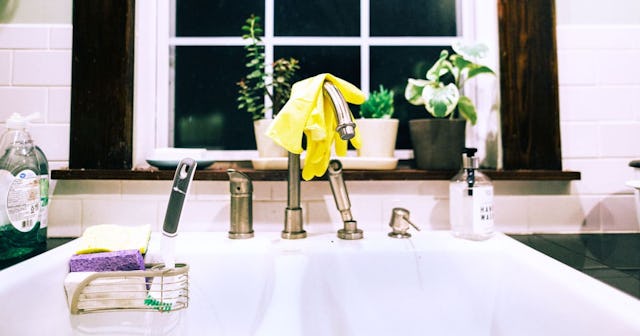We’re Freaking Out About The Wrong Thing When It Comes To Germs In Our Homes

I consider myself somewhat of a germaphobe. If I know that someone is even a little bit sick, I will cancel plans so that my kids and I don’t get infected. I make my kids wash their hands as soon as they get home, I carry around hand sanitizer everywhere I go, and I’ve been known to re-sanitize my bathroom if someone comes over and has clearly taken a dump in my toilet.
In fact, my toilet is probably the cleanest thing in my house. It gets scrubbed and bleached weekly, plus any quick maintenance cleans during the week. I’m usually one to use natural cleaners and such, but when it comes to the toilet, I go full-on BLEACH. Because the toilet is the most germy, disease-festering place in my home, right?
Well, it turns out I’m totally wrong about that. And you might be too. According to microbiologist Charles Gerba, of the University of Arizona, your toilet is probably one of the least germy parts of your house. It’s the whole rest of your house that’s crawling with disease-festering microbes.
“There’s more fecal bacteria in your kitchen sink than there is in a toilet after you flush it,” Gerba said in an interview with CNN. “That’s why your dog drinks out of the toilet. He’s smarter than you think.”
Welp.
Gerba explains that because we generally focus on keeping our toilets clean — regularly sanitizing them — they are actually one of the cleanest parts of our homes.
Sarah Giegerich/Reshot
In terms of the bathroom, Gerba says that generally the germs we come into contact with are our own, which don’t usually pose a threat to us. Of course, when others come into the bathroom, especially if they have a GI virus or a bacterial infection, we are in a bit more danger.
(See, I’m not totally bonkers for sanitizing my toilet when guests come over and use my bathroom.)
However, according to Gerba, I should most definitely be changing my towels as well, because towels are the perfect place for viruses and bacteria to par-tay.
“E. coli grows quite well on towels. Within about three or four days, you’ll get fecal bacteria in the towel easily because it’s wet, it’s moist,” Gerba said.
Well, that’s just freaking lovely.
And it’s not just when company comes over and shits in your toilet. Anyone in your home could be harboring a bit of E. coli — and the problem is that it can be really difficult to remove.
“You should change your towels every three or four days at least, because you can cross-contaminate other people in your house,” Gerba advised, also explaining that it’s very difficult to remove bacteria from towels, even with normal washing, because of how thick and absorbent they are.
“You’ll get more E. coli in your face when you dry your face with a towel at home than if you stuck your head in a toilet and flushed,” Gerba said. “You’ve got to use hot water wash and dry towels really well.”
But Gerba warns that it’s not even really the bathroom that harbors the most germs. It’s our kitchens – where food is prepared and eaten – that are probably the grossest parts of our home.
The reason why, according to Gerba, is that the kitchen is where we prepare foods that may have bacteria like salmonella and E. coli in them – and that we don’t frequently sanitize places like our kitchen sinks and cutting boards.
Yep: I’m definitely guilty of that. I’ll wipe all that stuff down, but I almost never sanitize those areas.
“Recent surveys of homes found more fecal bacteria on a cutting board in the average home than a toilet seat,” said Gerba.
Darby S/Reshot
OK, I definitely will not be chopping onions on my toilet seat anytime soon, but he does have a point.
Gerba recommends sanitizing cutting boards, and anywhere else food is washed, cleaned, and prepared, with bleach.
But it’s not just your cutting board, sink, and countertops you need to be aware of. Apparently, there are several hidden “hot spots” where germs can dwell. The most often neglected one? Your kitchen sponge.
Yep, like your bathroom towels, your kitchen sponges are fantastic at absorbing bacteria. Gerba told CNN that his research found that up to 15% of kitchen sponges have salmonella in them.
SHIIIITTTT.
And clearly most of us don’t clean or sanitize those damn sponges nearly as often as we should.
Other often-neglected kitchen items and areas include our dishrags and fridge handles, along with the water reservoir of our coffee pots. I mean, who in fresh hell cleans the goddamn water reservoir of a coffee pot?
I would have never in a million years thought to do that.
Now, look: This stuff is seriously disturbing when you think about it. E.coli leaping all over your bathroom towels and then onto your hands and face is not something anyone enjoys thinking about.
At the same time, we can’t go bananas here, sanitizing our homes every time we microwave a plate of chicken nuggets for our kids. And anyway, science has proven that a little bit of exposure to common bacteria is actually healthy for our immune systems and that over-sanitizing can be problematic as well.
So yes, we should all take basic precautions to keep ourselves safe from viruses and bacteria. And it’s probably wise to sanitize our kitchens and wash our bath towels a wee bit more than most of us do.
But it’s also important not to get too hung up about this stuff. It seems to me that taking a middle-ground approach to it all makes the most sense here.
This article was originally published on